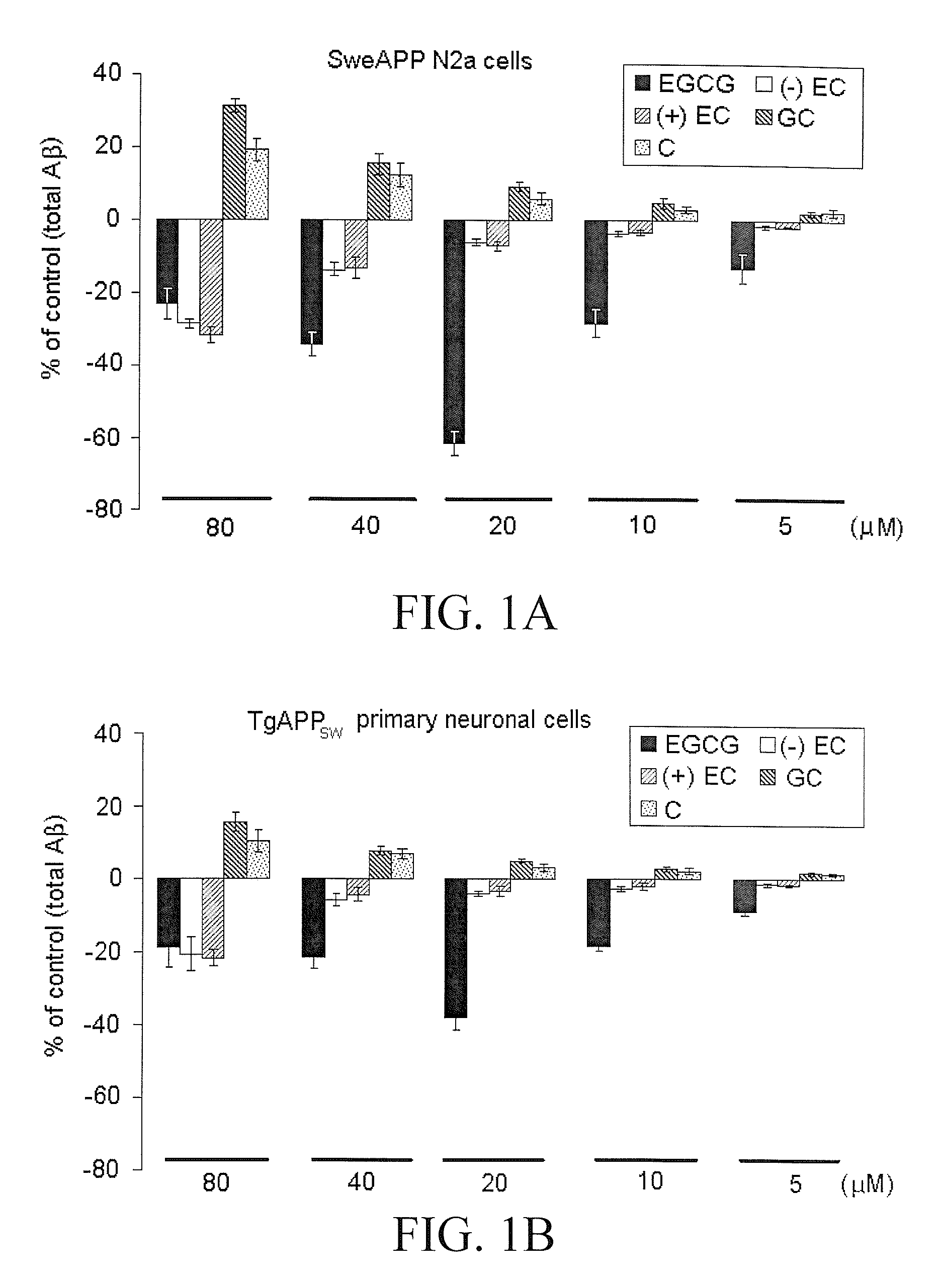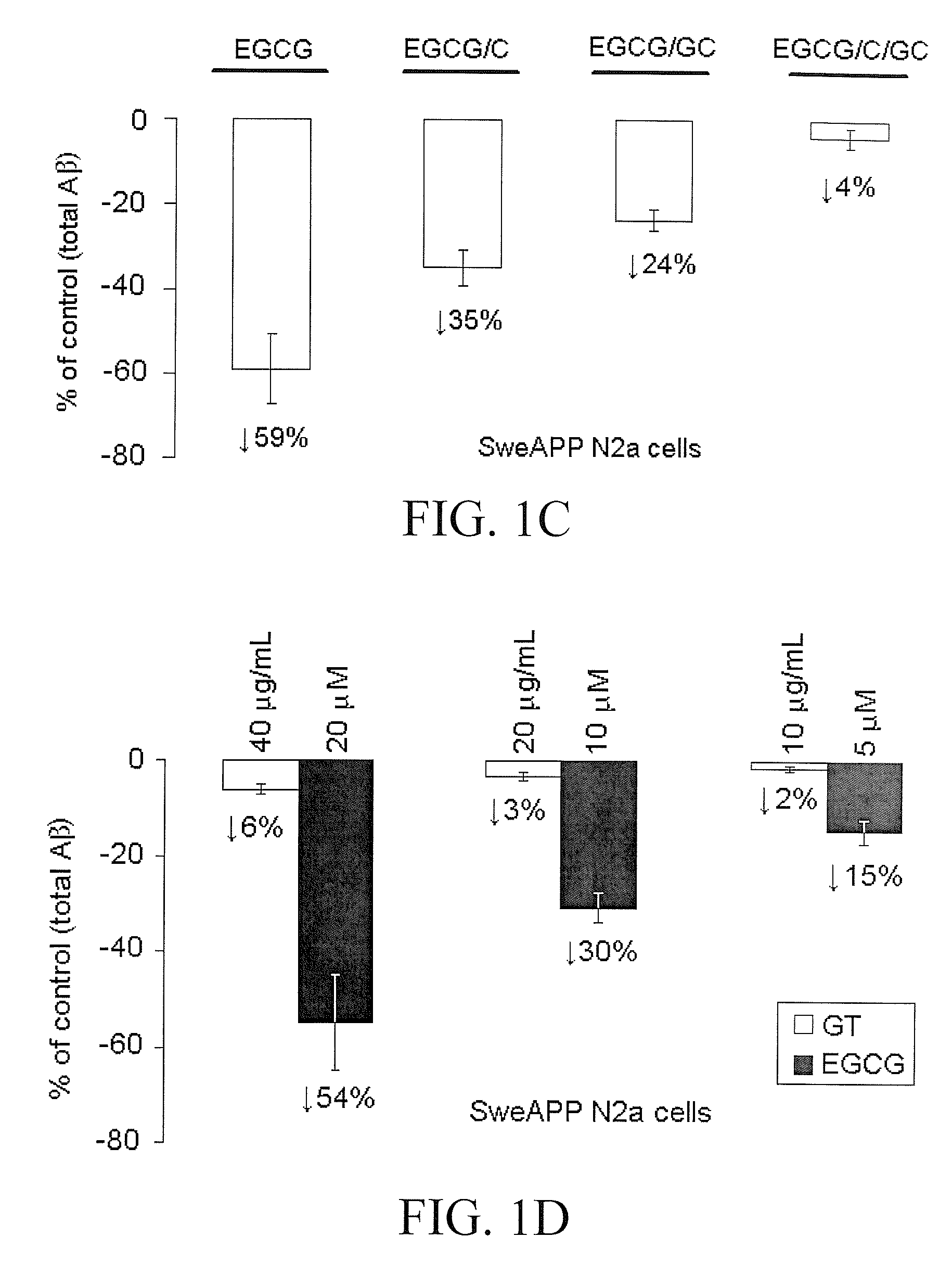Green tea polyphenol alpha secretase enhancers and methods of use
a technology of green tea and enhancers, which is applied in the field of green tea polyphenol alpha secretase enhancers and methods of use, can solve the problems of no reports as to the active ingredients of green tea, and achieve the effect of increasing expression and/or activity
- Summary
- Abstract
- Description
- Claims
- Application Information
AI Technical Summary
Benefits of technology
Problems solved by technology
Method used
Image
Examples
example 1
Green Tea Polyphenol EGCG Markedly Inhibits Aβ1-42 Production in Murine N2a Cells Transfected with Human Wild-Type APP695 and Transgenic APPSW Mouse-Derived Primary Neuronal Cells
[0067]The HPLC analysis of green tea shows that EGCG is the major component along with others, including (−)-epicatechin [(−) EC], (+)-epicatechin [(+) EC], (−)-gallocatechin (GC) and (−)-catechin (C). In order to examine the effects of green tea's components on APP cleavage processing, for a first step, N2a neuroblastoma cells overproducing Aβ were treated with each of the aforementioned components at a wide range of doses. In addition, doses of (+)-catechin hydrate (CH) and gallic acid monohydrate (GAM) were included in the first step. EGCG markedly reduced Aβ1-42 generation in either human wild-type APP695-transfected N2a cells or primary transgenic APPsw-derived neuronal cells in a dose-dependent manner (FIGS. 1A and 1B). Most importantly, at 20 μM, EGCG treatment reduced Aβ1-42 generation in both human...
example 2
Analysis of Alteration of CTFs and Secreted Forms of APP in Human Wild-Type APP695-Transfected N2a Cells After EGCG Treatment
[0069]To unravel the underlying mechanisms, APP cleavages following EGCG treatment in human APP695-transfected N2a cells were examined using Western immunoblotting and immunoprecipitation. As expected, EGCG treatment results in a greatly increased α-CTF generation and ratio of α-CTF to β-CTF band density in a dose-dependent manner (FIG. 2A). In addition, treatment with either (−) EC only or (+) EC only increases α-CTF production at the high dose (FIGS. 2A and 2B). Furthermore, there are not any changes in total APP and holo APP expression in cells treated with EGCG treated condition (FIGS. 2B and 2C), suggesting that this treatment promotes APP α-cleavage rather than stimulates the expression of APP. Accordingly, the secreted form of APP-α (sAPP-α) was markedly increased in the cell cultured medium following EGCG treatment at 20 μM for 18 hours (FIG. 2D), whic...
example 3
Characterization of EGCG-Promoted α-Secretase Cleavage of APP in Human Wild-Type APP695-Transfected N2a Cells
[0071]As shown in FIG. 2C, Western immunoblotting analysis clearly shows a time dependent pattern of APP α-CTF generated by EGCG-treated human APP695-transfected N2a cells. Most notably, α-CTF generation is drastically increased in 3 to 4 hours and then through to 8 hours after EGCG treatment (FIG. 2C). To test whether the alteration of APP α-CTF could correlate with α-secretase cleavage activity, for the first step, the expression of TNF-a converting enzyme (TACE), one of candidates for α-secretase cleavage of APP, following EGCG treatment at the same point was examined using Western immunoblotting. Results show that TACE expression is significantly increased in 3 to 4 hours following EGCG treatment and then rapidly cleaved through 8 hours (FIG. 3A). Furthermore, α-secretase cleavage activity in the cell lysate prepared from EGCG-PBS-treated human APP695-transfected N2a cell...
PUM
| Property | Measurement | Unit |
|---|---|---|
| concentration | aaaaa | aaaaa |
| time | aaaaa | aaaaa |
| particle size | aaaaa | aaaaa |
Abstract
Description
Claims
Application Information
 Login to View More
Login to View More - R&D
- Intellectual Property
- Life Sciences
- Materials
- Tech Scout
- Unparalleled Data Quality
- Higher Quality Content
- 60% Fewer Hallucinations
Browse by: Latest US Patents, China's latest patents, Technical Efficacy Thesaurus, Application Domain, Technology Topic, Popular Technical Reports.
© 2025 PatSnap. All rights reserved.Legal|Privacy policy|Modern Slavery Act Transparency Statement|Sitemap|About US| Contact US: help@patsnap.com



